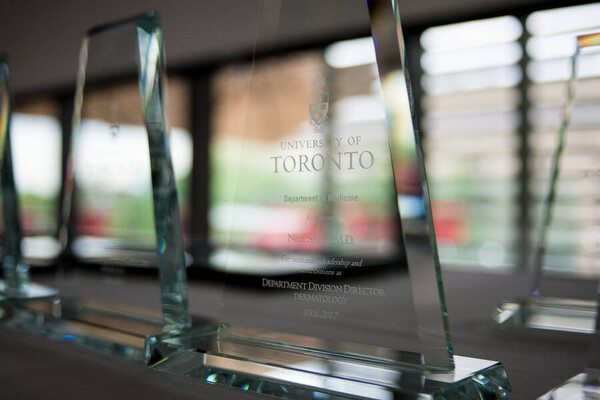Main Second Level Navigation
- Welcome
- Why Toronto?
- History of the Department
- Vision & Strategic Priorities
- Our Leadership
- Our Support Staff
- Location & Contact
- Departmental Committees
- Department of Medicine Prizes & Awards
- Department of Medicine Resident Awards
- Department of Medicine: Self-Study Report (2013 - 2018)
- Department of Medicine: Self-Study Report (2018 - 2023)
- Communication Resources
- News
- Events
Dermatology: Residency Program Update

Dr. Scott Walsh, Assistant Professor & Program Director, Dermatology Residency Program, University of Toronto Staff Dermatologist, Sunnybrook Health Sciences Centre
With a complement of 33 Residents, the University of Toronto has the largest Dermatology training program in Canada and one of the largest in North America. Our Residents rotate through four core teaching hospitals (Women’s College, Toronto Western, Sunnybrook and the Hospital for Sick Children), cover the in-patient consultation services at the aforementioned four hospitals plus Princess Margaret and Toronto General, and rotate through various community offices and clinics. As we gear up for the Canadian Residency Matching Service (CaRMS) 2018, Dermatology Residency remains one of the most competitive primary subspecialties with a ratio of approximately fifteen applicants to every one position at U of T.
The teaching Program is designed with an intern year of internal medicine and subspecialties with core dermatology weekly, a second year more focused to the various branches of dermatology and related fields and three core years of all aspects of dermatology (pediatric and adult), dermatologic surgery, dermatopathology and cosmetic and procedural dermatology.
The University of Toronto remains in collaboration with McMaster University for a joint training position in Dermatology where the Resident is based in Hamilton for the first two years and receives a large component of core dermatology in Toronto for the final 3 years of training.
Research is a core focus of training in our Residency Program and several Residents have been successful in securing grant funding from the Canadian Dermatology Foundation among several other funding agencies. Our Residents regularly present at the National and International Conferences as well as our own Resident Research Day.
The Program has a strong clinical base as well with subspecialty clinics in cutaneous lymphomas, immunobullous diseases, hair, vascular malformations, epidermolysis bullosa, complex medical dermatology and childhood morphea. There are a dedicated group of Dermatopathologists who teach concepts in dermatopathology weekly as well as during dedicated rotations. Cosmetics and procedural dermatology including Mohs Micrographic Surgery have dedicated teachers and rotations.
Our Residents have been very successful in securing opportunities through the American Academy of Dermatology including electives in Botswana and attending conferences in European Countries, as well as through the Canadian Dermatology Association and several Residents have participated in Camp Liberte.
It really is the dedication of the Residents and their innovations that continue to make the Program grow and a collegial group of very committed staff (both full and part-time) that continue to ensure a solid and fulfilling residency experience.

